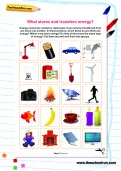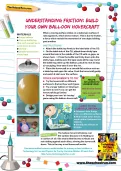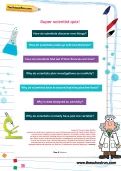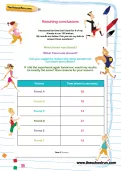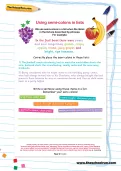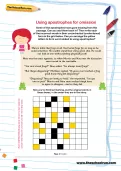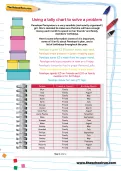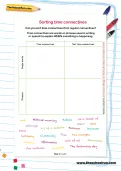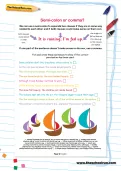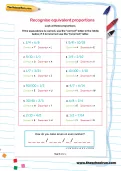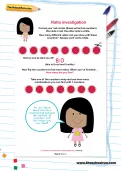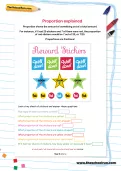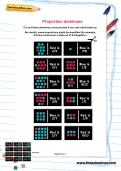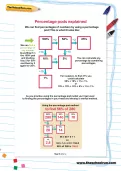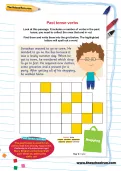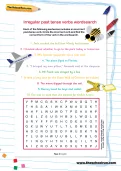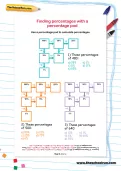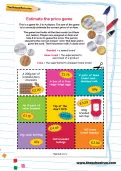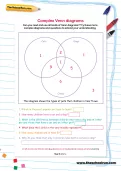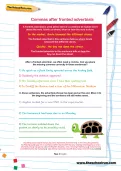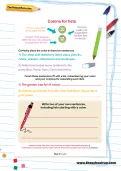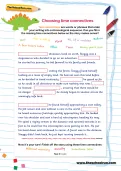We use semi-colons in a list when the items in the list are described by phrases. Can you correctly place the semi-colons in these lists?
or
Register to add to your saved resources
Already a subscriber? to view this content.
Some of the apostrophes have gone missing from this passage. Can you add them back in? Then write each of the incorrect words in their uncontracted (unshortened) form in the grid below. Can you arrange the yellow letters to form word related to using apostrophes?
or
Register to add to your saved resources
Already a subscriber? to view this content.
Penelope Pennywise is a very sensible (and scarily organised!) girl. She’s decided to make sure that she will have enough money each month to spend on her friends’ and family members’ birthdays. Here’s some information (some of it is important, some of it isn’t) about Penelope’s plan, and a list of birthdays throughout the year. Use the tally chart to help you work out how much Penelope will need to spend each month on birthdays. Will she be able to buy presents for everyone on her list?
or
Register to add to your saved resources
Already a subscriber? to view this content.
Jennifer has gone a bit capital-letter-mad writing a letter about her interests and hobbies! Circle the words that shouldn’t have a capital letter, then find them in the wordsearch.
or
Register to add to your saved resources
Already a subscriber? to view this content.
Time connectives are words or phrases used in writing or speech to explain WHEN something is happening. Can you sort these time connectives from regular connectives?
or
Register to add to your saved resources
Already a subscriber? to view this content.
We can use a semi-colon to separate two clauses if they are in some way related to each other and if both clauses could make sense on their own. If one part of the sentence doesn’t make sense on its own, use a comma. Tick and cross these sentences to show if the correct punctuation has been used.
or
Register to add to your saved resources
If the equivalence is correct, use the “correct” letter in the riddle below; if it is incorrect use the “incorrect” letter.
or
Register to add to your saved resources
Already a subscriber? to view this content.
Cut out your red circles (these will act as counters). One side is red, the other side is white. How many different ratios can you show with these counters? Now flip the counters to find more ratios. When you’ve finished… How many did you find?
or
Register to add to your saved resources
Already a subscriber? to view this content.
Proportion shows the amount of something out of a total amount. For instance, if I had 20 stickers and 7 of them were red, the proportion of red stickers would be 7 out of 20, or 7/20. Proportions are fractions!
or
Register to add to your saved resources
Already a subscriber? to view this content.
Cut out these dominoes cards and see if you can match them up. Be careful, some proportions might be simplified (for example, 2/3 blue could mean 4 blue out of 6 altogether).
or
Register to add to your saved resources
Already a subscriber? to view this content.
We can find percentages of numbers by using a percentage pod! As you practise using the percentage pod model you’ll get used to finding the percentages in your head and develop a mental method.
or
Register to add to your saved resources
Already a subscriber? to view this content.
Look at this passage. It includes a number of verbs in the past tense; you need to collect the ones that end in -ed. Find them and write them into the grid below. The highlighted letters will spell out a word.
or
Register to add to your saved resources
Already a subscriber? to view this content.
A fun and free activity created by an experienced teacher with the aim of teaching KS2 children about irregular past tense verbs. Each of the sentences on the worksheet includes an incorrect past-tense verb. Circle the incorrect verb and then find the correct form of the verb in the wordsearch.
or
Register to add to your saved resources
Do you know how to use a percentage pod? Use a percentage pod to calculate theses percentages.
or
Register to add to your saved resources
Already a subscriber? to view this content.
Before we do a calculation it’s useful to make a quick estimate. This helps because when we complete the calculation we will know if we are right or not based on the closeness to the estimation.Can you estimate the answers to the following? Remember to estimate, don’t do the working out!
or
Register to add to your saved resources
Already a subscriber? to view this content.
This is a game for 2 to 4 players. The aim of the game is to correctly estimate the correct price of an item. The game host holds all the item cards. Players are assigned an item and take it in turns to guess the price. The person closest to the correct answer ‘wins’ that item and is given the card. The first person with 3 cards wins!
or
Register to add to your saved resources
Can you read and use all kinds of Venn diagrams? Try these more complex diagrams and questions to extend your understanding.
or
Register to add to your saved resources
Already a subscriber? to view this content.
A fronted adverbial is used at the start of a sentence to explain more about the verb. It tells us where, when or how the verb is done. After a fronted adverbial, we often need a comma. Can you place the missing commas correctly in these sentences?
or
Register to add to your saved resources
Already a subscriber? to view this content.
Can you correctly place the colon in these two sentences then finish these sentences off with a list, remembering your colon and your commas for separating each item.
or
Register to add to your saved resources
Already a subscriber? to view this content.
Time connectives are words or phrases that order your writing into a chronological sequence. Can you fill in the missing time connectives below so the story makes sense?
or
Register to add to your saved resources
Already a subscriber? to view this content.
